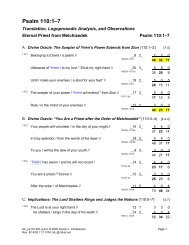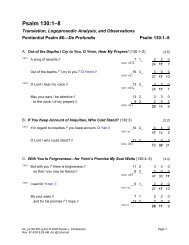Reading Genesis 1-2 in Hebrew - Bibal.Net
Reading Genesis 1-2 in Hebrew - Bibal.Net
Reading Genesis 1-2 in Hebrew - Bibal.Net
You also want an ePaper? Increase the reach of your titles
YUMPU automatically turns print PDFs into web optimized ePapers that Google loves.
<strong>Read<strong>in</strong>g</strong> <strong>Genesis</strong> 1–2 <strong>in</strong> <strong>Hebrew</strong><br />
the root (“go, come”) with the 3 rd sg. fem. pronom<strong>in</strong>al suffix Ahñ (“her”). The preposition -le'<br />
(“to”) <strong>in</strong>dicates direction—G-d brought the woman to the human.<br />
�������������„<br />
������������������������‰������π���������˜���������������<br />
�����π���������˜����������������œ•���2:23�<br />
�������������„<br />
������������������������‰����<br />
�����“‘���›�������„ ������û�ƒ����������������������������<br />
�œ•��—transliteration: way-yOµ'-mer hA-'A-dAµm<br />
zOµ't haP-Paµ-vAm vEµ-cem mE-v·-cA-maµy ˚-bA-WAµr miB-B¸-WA-rÓµ, “and the human said, ‘This one this<br />
time is bone from my bones and flesh from my flesh.” The verb here is Qal imperfect 3 rd sg.<br />
masc. with wau-conversive from the root rm' (“say”) with £AdA'Ah (“the human”) as subject. The<br />
fem. sg. demonstrative pronoun tO'z (“this”) stands <strong>in</strong> apposition to the substantive £avLapah (“the<br />
occurrence”) with the mean<strong>in</strong>g “now at length.” The def<strong>in</strong>ite article here carries demonstrative<br />
force. As J. G. Herder put it long ago, the man reacts with a “jubilant welcome” to the creation of<br />
woman. Note that the ' here <strong>in</strong> the word tO'z is silent and that this word is repeated three times<br />
<strong>in</strong> this verse, referr<strong>in</strong>g to the woman <strong>in</strong> each <strong>in</strong>stance. The verb “to be” is understood. The<br />
phrase yamAc‹vEm £ecev (“bone from my bones”) parallels that of yirAW–¯bim rAWAb˚ (“flesh from my flesh”).<br />
Note the different vowels <strong>in</strong> the two occurrences of the preposition §im (“from”), both of which<br />
have assimilation of the n˚n; for there is compensatory lengthen<strong>in</strong>g of the vowel when the<br />
follow<strong>in</strong>g guttural cannot be doubled. Note also the different vowels <strong>in</strong> the affixed personal<br />
pronouns with yañ <strong>in</strong> the first <strong>in</strong>stance and yiñ <strong>in</strong> the second. In the first <strong>in</strong>stance the pronom<strong>in</strong>al<br />
suffix is affixed to the construct form of the plural £yimAc‹v (“bones”).<br />
�����������������������—transliteration:<br />
l¸-zOµ't yiq-qA-rEµ' 'iH-H‰µ, “<strong>in</strong>deed, (as for) this one, it will be<br />
called Woman ...” The l attached to the fem<strong>in</strong><strong>in</strong>e demonstrative pronoun t'z (“this”) appears to<br />
be emphatic. It is not clear why the verb that follows is mascul<strong>in</strong>e. The verb is Niphal imperfect<br />
3 rd sg. masc. from the root 'rq (“call”). The fem. noun hLAHi' (“woman”) is a sound play on the<br />
word Hyi' (“man”), though the two words are apparently not related etymologically. The word<br />
hLAHi' is derived from the root Hn' (“be delicate, soft”) whereas the word Hyi' is derived from the<br />
root Hy' or Hw' (with apparent mean<strong>in</strong>g “be strong”).<br />
�����“‘���›�������„ ������û�ƒ—transliteration:<br />
KÓµ mE'ÓµüH luqAxAh-zOµ't, “for from man this one has been<br />
taken.” The verb ���›���� [for ���› –����] is Pual (passive) perfect 3 rd sg. masc. from the root xql<br />
(“take”) with “this one” (i.e., Woman”). The preposition §im (“from”) is prefixed to the noun Hyi'<br />
(“man”) with assimilation of the n˚n and compensatory lengthen<strong>in</strong>g of the vowel because the<br />
follow<strong>in</strong>g consonant cannot be doubled. The dot <strong>in</strong> the z here is the conjunctive daghesh. When<br />
a word end<strong>in</strong>g <strong>in</strong> an unstressed ñA(h) or ñeh is followed by one beg<strong>in</strong>n<strong>in</strong>g with a stressed<br />
syllable, a daghesh may be placed <strong>in</strong> the first consonant of the second word. Though there is<br />
etiological concern <strong>in</strong> <strong>Genesis</strong> 2, this does not make the narrative itself a name etiology. The<br />
narrative is not concerned with the orig<strong>in</strong> of mutual attraction of the sexes as such but with the<br />
complementary relationship between man and woman. It concerns the great importance of the<br />
© 2005 BIBAL Corporation, All Rights Reserved Version 1.0<br />
36





